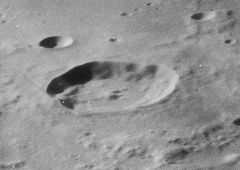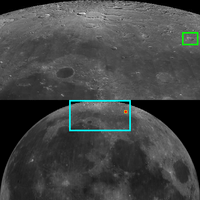Democritus (crater)
|
Location of the crater Democritus. | |
| Coordinates | 62°18′N 35°00′E / 62.3°N 35.0°ECoordinates: 62°18′N 35°00′E / 62.3°N 35.0°E |
|---|---|
| Diameter | 39 km |
| Depth | 2.0 km |
| Colongitude | 325° at sunrise |
| Eponym | Democritus |

Democritus is a lunar impact crater that is located on the northern part of the Moon, just to the north of the Mare Frigoris. Just to the south of Democritus is the lava-flooded crater Gärtner, which forms a bay on the mare. Directly to the north is Arnold, another flooded formation.
Description
The rim of Democritus is generally sharp-edged and shows little sign of erosion. It forms not quite a circle, with outward notch-like bulges that give it a slightly irregular shape. The inner walls have single or double terraces that lead down to a relatively flat interior floor. Near the midpoint of the crater is a small central peak.
Names
Democritus is named after the Greek philosopher of the same name. Like many of the craters on the Moon's near side, it was given its name by Giovanni Riccioli, whose 1651 nomenclature system has become standardized.[1] Earlier lunar cartographers had given the feature different names: Michael van Langren's 1645 map calls it "Alfonsi IX Reg. Cast." after Alfonso IX of León and Castile,[2] and Johannes Hevelius called it "Mons Bontas".[3]
Satellite craters
By convention these features are identified on lunar maps by placing the letter on the side of the crater midpoint that is closest to Democritus.
| Democritus | Latitude | Longitude | Diameter |
|---|---|---|---|
| A | 61.6° N | 32.4° E | 11 km |
| B | 60.1° N | 28.6° E | 12 km |
| D | 62.9° N | 31.2° E | 8 km |
| K | 63.1° N | 40.7° E | 7 km |
| L | 63.4° N | 39.7° E | 18 km |
| M | 63.6° N | 37.1° E | 5 km |
| N | 63.6° N | 34.3° E | 16 km |
References
- ↑ Ewen A. Whitaker, Mapping and Naming the Moon (Cambridge University Press, 1999), p.212.
- ↑ Ewen A. Whitaker, Mapping and Naming the Moon (Cambridge University Press, 1999), p. 198.
- ↑ Ewen A. Whitaker, Mapping and Naming the Moon (Cambridge University Press, 1999), p. 202.
- Andersson, L. E.; Whitaker, E. A. (1982). NASA Catalogue of Lunar Nomenclature. NASA RP-1097.
- Blue, Jennifer (July 25, 2007). "Gazetteer of Planetary Nomenclature". USGS. Retrieved 2007-08-05.
- Bussey, B.; Spudis, P. (2004). The Clementine Atlas of the Moon. New York: Cambridge University Press. ISBN 978-0-521-81528-4.
- Cocks, Elijah E.; Cocks, Josiah C. (1995). Who's Who on the Moon: A Biographical Dictionary of Lunar Nomenclature. Tudor Publishers. ISBN 978-0-936389-27-1.
- McDowell, Jonathan (July 15, 2007). "Lunar Nomenclature". Jonathan's Space Report. Retrieved 2007-10-24.
- Menzel, D. H.; Minnaert, M.; Levin, B.; Dollfus, A.; Bell, B. (1971). "Report on Lunar Nomenclature by the Working Group of Commission 17 of the IAU". Space Science Reviews 12 (2): 136–186. Bibcode:1971SSRv...12..136M. doi:10.1007/BF00171763.
- Moore, Patrick (2001). On the Moon. Sterling Publishing Co. ISBN 978-0-304-35469-6.
- Price, Fred W. (1988). The Moon Observer's Handbook. Cambridge University Press. ISBN 978-0-521-33500-3.
- Rükl, Antonín (1990). Atlas of the Moon. Kalmbach Books. ISBN 978-0-913135-17-4.
- Webb, Rev. T. W. (1962). Celestial Objects for Common Telescopes (6th revision ed.). Dover. ISBN 978-0-486-20917-3.
- Whitaker, Ewen A. (1999). Mapping and Naming the Moon. Cambridge University Press. ISBN 978-0-521-62248-6.
- Wlasuk, Peter T. (2000). Observing the Moon. Springer. ISBN 978-1-85233-193-1.
| Wikimedia Commons has media related to Image:Lunar_crater_Democritus.png. |
